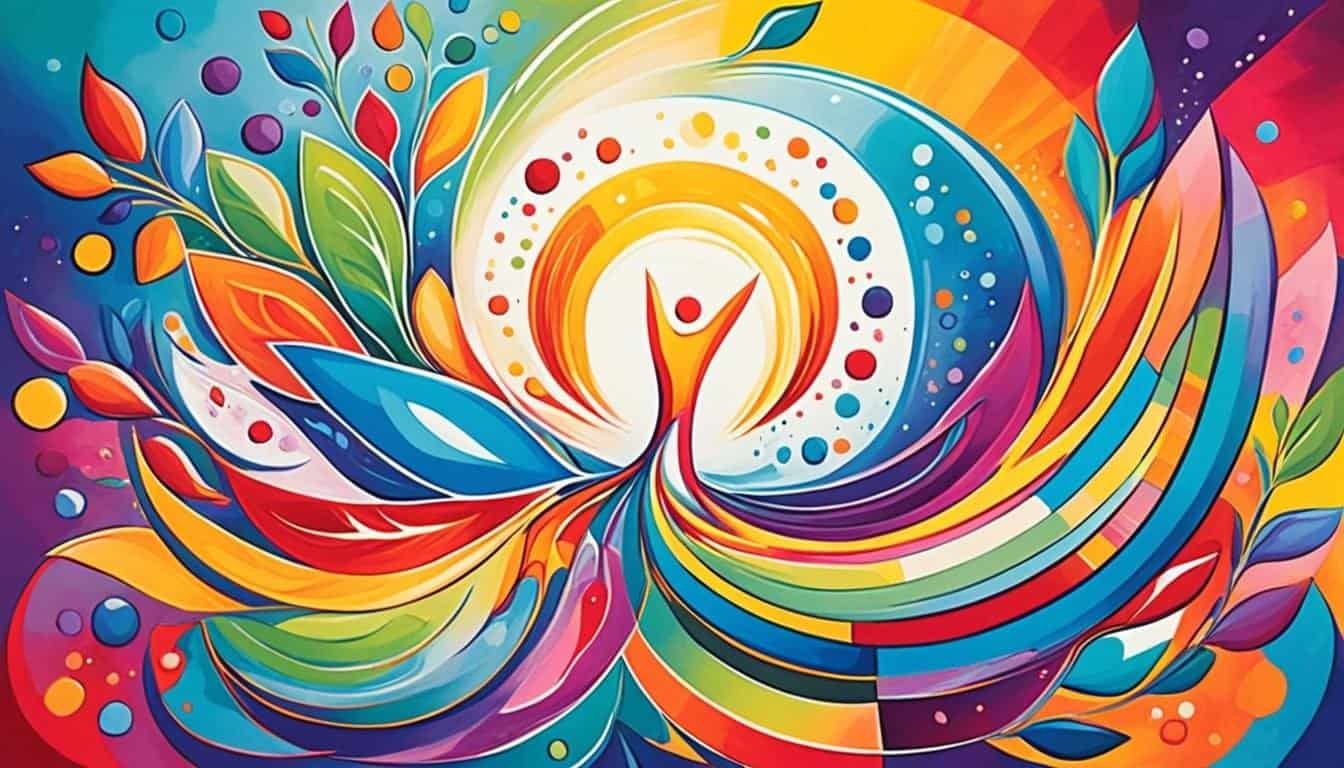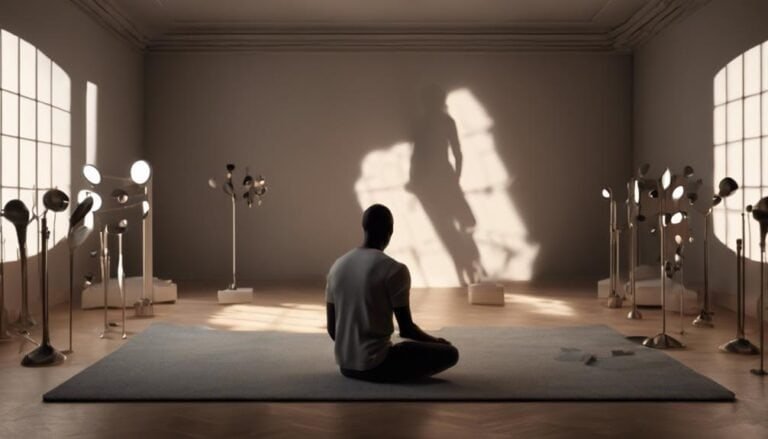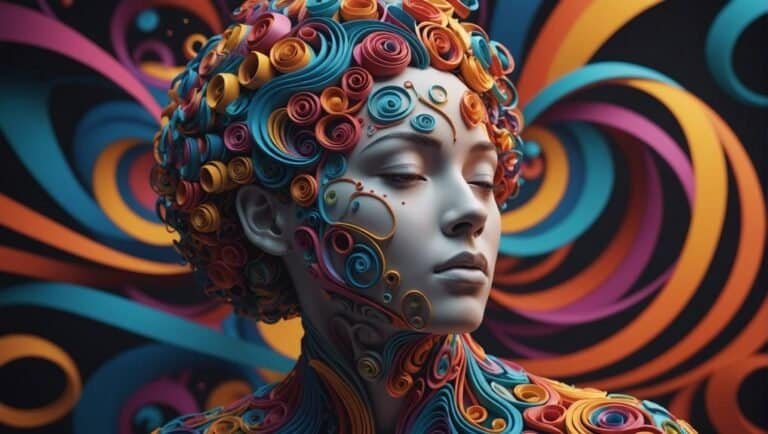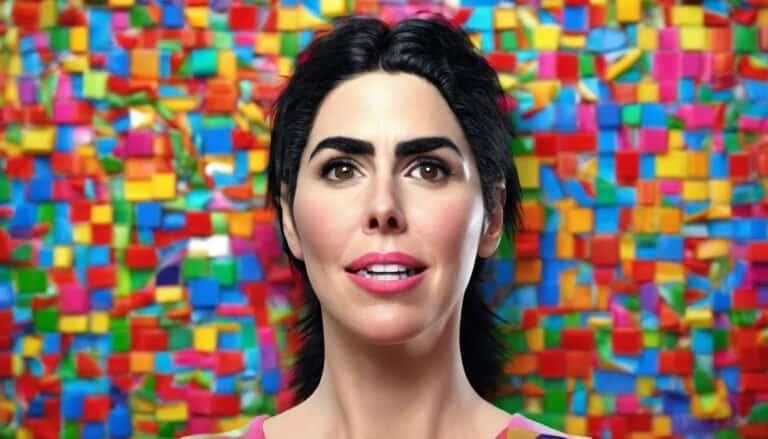Explore Healing with Transpersonal Art Therapy
“Art is not freedom from discipline, but disciplined freedom.” – John F. Kennedy
Transpersonal Art Therapy is a holistic approach to healing that combines psychology and spirituality. Through creative expression, individuals can delve into their inner world, unlock their potential, and discover new paths to healing. This form of therapy utilizes a range of tools and techniques to promote self-discovery and personal growth. By harnessing the power of art, individuals can embark on a transformative journey towards wholeness and well-being.
Key Takeaways:
- Transpersonal Art Therapy is a holistic approach that combines psychology and spirituality.
- Art therapy allows individuals to explore their inner world and express themselves through creative expression.
- Art therapy techniques can promote self-discovery, personal growth, and healing.
- Through disciplined freedom, individuals can unlock their potential and embark on a transformative journey.
- Transpersonal Art Therapy is a powerful tool for wholeness and well-being.
The Power of Art Therapy for Mental Health
Art therapy has long been recognized as a powerful tool for improving mental health and well-being. It provides individuals with a creative outlet to express their emotions, reconcile conflicts, and foster self-awareness. Through the process of creating art, individuals can develop problem-solving skills, reduce anxiety, and gain insight into their thoughts and feelings.
Art therapy is widely utilized in various settings, including private practice, hospitals, schools, and more. It is a versatile approach that can benefit diverse populations, ranging from children and adolescents to dementia patients. By engaging in art-making, individuals can tap into their inner resources and discover new ways of healing and self-expression.
Art therapy is not limited to traditional forms of art such as painting and drawing. It encompasses a wide range of mediums and techniques, including collage, sculpture, and even digital art. This flexibility allows individuals to find the medium that resonates with them the most, enabling them to express themselves in a way that feels authentic and meaningful.
Expressing Emotions through Art
One of the fundamental aspects of art therapy is the ability to express emotions that may be difficult to put into words. Through art, individuals can translate their innermost feelings into visual representations, providing a tangible outlet for their emotions. This process allows for catharsis and emotional release, promoting a sense of relief and well-being.
Art therapy also offers a safe and non-judgmental space for individuals to explore and confront their emotions. It encourages self-reflection and introspection, promoting self-awareness and personal growth. By engaging in the creative process, individuals can gain a deeper understanding of themselves and their experiences, leading to increased self-confidence and empowerment.
“Art therapy provides individuals with a unique opportunity to explore their inner world and gain insight into their thoughts and emotions. It allows for personal growth and healing through the creative process.” – Dr. Emily Smith, Art Therapist
Enhancing Problem-Solving Skills
Art therapy also helps individuals develop problem-solving skills through the creative process. When creating art, individuals are faced with challenges and obstacles that require them to think outside the box and find unique solutions. This process of problem-solving in art therapy translates to real-life situations, fostering resilience and adaptability.
Furthermore, art therapy encourages individuals to explore different perspectives and alternative ways of thinking. By creating art, individuals can step outside of their comfort zones and explore new possibilities. This flexibility and openness to experimentation can lead to innovative thinking and problem-solving in other areas of life.
The Healing Power of Art Therapy
Art therapy has the potential to promote healing on multiple levels, including emotional, psychological, and spiritual. It provides individuals with a safe and supportive environment to process trauma, grief, and other emotional challenges. Through art-making, individuals can find solace, healing, and a sense of connection.
The creative process of art therapy can also foster a sense of mindfulness and presence, allowing individuals to focus on the present moment and let go of worries and stressors. Engaging in art-making can be a meditative and soothing experience, promoting relaxation and stress relief.
| Benefits of Art Therapy for Mental Health | Examples of Art Therapy Techniques |
|---|---|
|
|
The Transformative Nature of Transpersonal Art Therapy
Transpersonal Art Therapy goes beyond the personal and focuses on transformation and self-discovery. It allows individuals to access deeper states of consciousness and explore their inner landscape through creative expression. This form of therapy is not limited to drawing; it can also involve painting, clay, mask work, dream exploration, and more. Through these modalities, meaning is amplified and new understandings and insights can be reached.
Unlocking the Power of Creative Expression
Transpersonal Art Therapy offers individuals a unique platform to express their deepest thoughts, emotions, and experiences. By engaging in creative activities, such as painting or mask work, individuals tap into their subconscious minds and access a rich source of symbolism and imagery. The process of creating art can be both cathartic and enlightening, allowing for the exploration of complex inner worlds and the discovery of hidden aspects of the self.
Transpersonal Art Therapy provides a transformative journey of self-discovery, where individuals can unlock their creativity and tap into their inner wisdom. Through various art modalities, such as painting and mask work, individuals gain a deeper understanding of themselves and their place in the world.
Self-Reflection and Personal Growth
Transpersonal Art Therapy encourages individuals to reflect on their artwork and explore the messages and meanings it conveys. Through this self-reflection, individuals gain insights into their emotions, beliefs, and experiences, paving the way for personal growth and transformation.
Engaging in creative expression through Transpersonal Art Therapy allows individuals to navigate their inner landscapes, bringing about profound self-discovery and personal growth. Through the exploration of dreams, symbols, and archetypes, individuals can uncover hidden aspects of themselves and journey towards wholeness.
Integration and Harmonization
Transpersonal Art Therapy facilitates the integration of different aspects of individuals’ lives, bringing harmony and balance. By working with various art modalities and exploring different dimensions of creativity, individuals can explore their spiritual, emotional, and physical selves and find alignment within themselves.
Transpersonal Art Therapy provides a space to integrate different aspects of the self, allowing individuals to unite fragmented parts and find inner harmony. Through artistic expression and self-exploration, individuals can cultivate a sense of wholeness and integration, leading to a transformative and fulfilling life.
Exploration of the Transpersonal Realm
Transpersonal Art Therapy offers individuals the opportunity to delve into the transpersonal realm, connecting with the universal and transcending the limitations of the personal self. Through creative expression, individuals can tap into deeper states of consciousness, accessing wisdom and insights beyond their everyday reality.
Transpersonal Art Therapy encompasses various techniques, including dream work, symbolic exploration, and working with archetypal images, allowing individuals to explore the transpersonal realms within themselves and connect with something greater than themselves.
The transformative nature of Transpersonal Art Therapy lies in its ability to bridge the personal and transpersonal, unlocking the individual’s potential for spiritual growth and self-discovery. Through the exploration of the transpersonal realm, individuals can transcend their limitations and connect with the universal, leading to profound transformation and self-realization.
The Transformative Nature of Transpersonal Art Therapy Table
| Benefits of Transpersonal Art Therapy | Examples |
|---|---|
| Self-discovery | Through creative expression, individuals can gain insight into their true selves and explore new aspects of their identity. |
| Transformation | Transpersonal Art Therapy allows individuals to undergo profound personal transformation and growth. |
| Creative expression | Artistic activities offer individuals a platform for self-expression, allowing them to communicate their thoughts and emotions non-verbally. |
| Spiritual exploration | Transpersonal Art Therapy facilitates the exploration of spirituality, connecting individuals with something greater than themselves. |
| Increased self-awareness | Through art, individuals can gain a deeper understanding of their thoughts, emotions, and experiences. |
The Role of the Transpersonal Art Therapist
The role of the Transpersonal Art Therapist is crucial in guiding clients through their journey of self-discovery and healing. Through the use of transpersonal art therapy, individuals can tap into their inner world and unlock the transformative power of creative expression.
Transpersonal art therapy is a client-centered approach that focuses on understanding and amplifying the client’s inner symbolic language. The art therapist acts as a bridge, facilitating communication between the client and their subconscious mind.
Art has long been recognized as a universal language, capable of expressing thoughts, emotions, and experiences that may be difficult to put into words. The art therapist helps clients identify and explore the personal significance behind their artwork, uncovering hidden meanings and insights.
By developing a deep understanding of the client’s unique experiences and needs, the transpersonal art therapist creates a safe and nurturing space for self-exploration. This client-centered approach ensures that the therapy process is tailored to the individual, allowing them to delve into their inner world at their own pace.
The therapeutic relationship between the art therapist and the client is built on trust, empathy, and non-judgment. The art therapist provides guidance and support, encouraging clients to express themselves authentically through various art mediums, such as painting, drawing, sculpting, or collage.
The client-centered nature of transpersonal art therapy empowers individuals to take ownership of their healing process, fostering self-discovery and personal growth. Through the transformative power of art, clients can develop a deeper understanding of themselves, gain insight into their emotions, and find new ways to navigate life’s challenges.
Key Qualities of a Transpersonal Art Therapist
| Qualities | Description |
|---|---|
| Empathy | An art therapist should possess a deep sense of empathy, allowing them to connect with clients on an emotional level and understand their unique experiences. |
| Active listening | Being able to actively listen and hold space for clients is essential in establishing a trusting therapeutic relationship. |
| Creativity | A transpersonal art therapist should have a strong creative mindset, allowing them to guide clients in exploring their artistic expression. |
| Flexibility | Flexibility is key in transpersonal art therapy, as each client’s journey is unique and may require different approaches and techniques. |
| Reflective practice | Continuously reflecting on their own practice and seeking professional development allows art therapists to enhance their skills and knowledge. |
Becoming an Art Therapist
Are you passionate about using art as a tool for healing and self-expression? If so, a career as an art therapist may be a perfect fit for you. Becoming an art therapist requires a combination of education, qualifications, and practical experience.
Art Therapy Courses
To start your journey towards becoming an art therapist, you’ll need to complete art therapy courses. These courses provide you with the necessary knowledge and skills to understand the therapeutic applications of art. They cover a wide range of topics, including psychology, human development, art media and techniques, and therapeutic approaches.
Art therapy courses also emphasize the development of empathy, excellent listening and communication skills, and creativity. These skills are essential for building rapport with clients, understanding their unique experiences, and guiding them through the therapeutic process.
Qualifications and Certification
After completing art therapy courses, you’ll need to meet the qualifications and requirements set by your country or region to practice as an art therapist. These qualifications typically include a master’s degree in art therapy or a related field, a specified number of supervised clinical hours, and passing a certification examination.
Obtaining certification as an art therapist demonstrates your commitment to ethical and professional standards in the field. It also enhances your credibility and opens up opportunities for employment in various settings, such as hospitals, mental health clinics, schools, and community centers.
Internship
As part of your journey to becoming an art therapist, you will need to complete an internship in a real-life setting. This internship provides you with valuable hands-on experience working with clients under the guidance of experienced professionals.
During your internship, you’ll have the opportunity to apply the knowledge and skills you’ve gained in art therapy courses. You’ll work directly with clients, facilitating their creative expression and supporting their emotional healing. This practical experience is invaluable in preparing you for a successful career as an art therapist.
Remember, becoming an art therapist is not just about artistic skills; it’s about connecting with people, understanding their emotions, and guiding them towards healing through creative expression. If you have a passion for helping others and a genuine interest in human behavior, art therapy may be the fulfilling career path you’ve been searching for.
Art Therapy Course Options
| Art Therapy Institute | Location | Duration | Accreditation |
|---|---|---|---|
| Art Therapy Education Center | New York, NY | 2 years | ACATE-accredited |
| Institute of Transpersonal Art Therapy | Los Angeles, CA | 1 year | ATCB-approved |
| International Art Therapy Organization | Online | Flexible | Non-accredited |
Art Therapy for Anxiety and Stress Relief
Anxiety and stress are common challenges many individuals face in their daily lives. The pressures of work, relationships, and the fast-paced nature of modern society can often leave us feeling overwhelmed and anxious. Fortunately, art therapy offers a powerful and effective approach to relieving these feelings and promoting overall well-being.
Art therapy allows individuals to express their inner thoughts, emotions, and fears through creative processes such as drawing, painting, and sculpting. By engaging in artistic activities, individuals can symbolize their anxieties and stressors, giving them a tangible form that can be explored and understood.
The act of creating art in a therapeutic setting provides a safe space for individuals to explore their emotions and experiences without judgment. Art becomes a powerful outlet for emotions that may be too challenging to express verbally, allowing individuals to release and process their anxieties in a healthy and constructive way.
Mindfulness is a key component of art therapy for anxiety and stress relief. When individuals engage in artistic activities, they are encouraged to be fully present in the moment, focusing their attention on the creative process rather than their worries or stressors. By practicing mindfulness, individuals can cultivate a sense of calm and relaxation, reducing the impact of anxiety and stress on their overall well-being.
“Art therapy provides individuals with a creative and insightful way to explore and manage their anxiety and stress. Through artistic expression, individuals can find clarity, perspective, and a sense of control over their emotions.”
Additionally, art therapy promotes self-reflection and self-discovery. Through the creation of art, individuals can gain a deeper understanding of their inner thoughts, emotions, and triggers. They can identify healthier coping mechanisms and develop strategies to manage their anxiety and stress more effectively.
The Benefits of Art Therapy for Anxiety and Stress Relief
Art therapy for anxiety and stress relief offers numerous benefits, including:
- Enhanced self-expression: Art provides a medium for individuals to express complex emotions and experiences that may be difficult to put into words.
- Symbolization and reframing: Art therapy allows individuals to symbolize their fears and anxieties, enabling them to reframe them in a more realistic and manageable manner.
- Emotional release: Creating art offers a cathartic and safe outlet for the expression and release of pent-up emotions, relieving anxiety and stress.
- Mind-body integration: Engaging in artistic activities helps integrate the mind and body, promoting a sense of harmony and well-being.
- Increased self-esteem: Through the creative process, individuals can develop a sense of accomplishment and pride in their artistic creations, boosting their self-esteem and confidence.
- Empowerment: Art therapy empowers individuals to take an active role in managing their anxiety and stress, fostering a sense of control and resilience.
Art therapy is a versatile and accessible approach to anxiety and stress relief. It can be tailored to suit individuals of all ages and abilities, making it an inclusive and effective therapeutic tool.
If you are looking for a holistic and creative way to manage your anxiety and stress, art therapy may be a valuable addition to your self-care routine. By embracing the power of art, you can find relief, self-discovery, and a renewed sense of calm and well-being.
Art Therapy for Depression
Art therapy can be a beneficial adjunct to traditional treatment for depression. It provides individuals with a creative and contemplative outlet to explore their feelings of sadness and emptiness. Through the process of creating art, individuals can gain new perspectives on their experiences and find meaning in their lives.
Depression can often leave individuals feeling stuck, isolated, and lacking a sense of purpose. However, art therapy offers a unique opportunity for self-expression and self-discovery. Through various art therapy techniques, individuals can tap into their inner resources and cultivate a new perspective on their journey towards recovery.
“Creating art allows individuals to externalize their internal struggles, enabling a deeper understanding of their emotions and experiences.”
Art therapy techniques such as family sculpture, coloring mandalas, and free-form painting can be particularly beneficial for individuals with depression. Family sculpture helps individuals explore their relationships and dynamics, shedding light on patterns and conflicts that may contribute to their depression.
Coloring mandalas, intricate circular designs, can promote relaxation, reduce stress, and support emotional healing. As individuals focus on coloring within the lines, they can experience a sense of control and accomplishment, fostering a positive mindset.
Free-form painting provides a space for individuals to express themselves freely, without judgment or expectations. It allows emotions to flow onto the canvas, providing an outlet for emotional release and catharsis.
“Art therapy encourages individuals to embrace their creativity, fostering a sense of empowerment and self-discovery.”
Throughout the art therapy process, individuals are encouraged to explore their artwork, reflect on their creations, and engage in a dialogue with the therapist. By doing so, they can gain insights into their thoughts, emotions, and underlying beliefs that contribute to their depression. This introspection can ignite a process of self-discovery, allowing individuals to develop coping strategies, cultivate self-compassion, and uncover new possibilities for personal growth.
“Art therapy provides a safe and supportive environment for individuals to express their emotions, discover their strengths, and find hope.”
Art therapy offers a creative approach to address the multifaceted nature of depression. It complements traditional treatment methods and provides individuals with a platform for self-expression, personal growth, and healing. Through art therapy, individuals can embark on a transformative journey towards a new perspective and a renewed sense of hope.
| Art Therapy Techniques for Depression | Benefits |
|---|---|
| Family Sculpture | Explore relationships and dynamics, uncover patterns and conflicts |
| Coloring Mandalas | Promote relaxation, reduce stress, support emotional healing |
| Free-form Painting | Provide a space for emotional release, expression, and catharsis |
Art Therapy for Adults and Children
Art therapy is a powerful and versatile form of therapy that benefits individuals of all ages. It allows for creative expression and provides a means of communication when words may be difficult to express. Art therapy enhances cognitive and sensorimotor functions, fosters self-awareness, and cultivates emotional resilience in adults.
For adults, art therapy can be particularly effective in treating a variety of mental health conditions, including depression, anxiety, dementia, Alzheimer’s disease, schizophrenia, and autism. Through art-making, individuals can explore their emotions, gain insight into their thoughts and feelings, and develop new coping strategies. Art therapy provides a safe and supportive environment for individuals to express themselves and process their experiences.
Additionally, art therapy for children is a valuable tool for both emotional and cognitive development. It enhances creativity, imagination, and emotional regulation. For children who may struggle with verbal expression, art provides a nonverbal outlet to communicate their thoughts, feelings, and experiences. Art therapy helps children develop self-esteem, problem-solving skills, and social interaction abilities.
Art therapy benefits individuals of all ages by promoting communication, creative expression, and emotional healing.
Through art, adults and children alike can tap into their creativity and explore their inner world. It offers a unique avenue for self-expression, allowing individuals to express emotions, thoughts, and experiences that may be difficult to put into words. Art therapy provides a safe space for individuals to explore their feelings and gain new perspectives.
The transformative power of art therapy extends to both adults and children, offering healing and personal growth. Whether it’s painting, drawing, sculpting, or other creative mediums, art therapy provides a holistic approach to well-being that nurtures the mind, body, and spirit.
| Benefits of Art Therapy for Adults | Benefits of Art Therapy for Children |
|---|---|
| Fosters self-awareness | Enhances creativity and imagination |
| Improves cognitive and sensorimotor functions | Aids emotional regulation |
| Cultivates emotional resilience | Develops problem-solving skills |
| Offers a nonverbal means of communication | Supports social interaction abilities |
| Effective in treating depression, anxiety, and other mental health conditions | Promotes self-esteem and self-expression |
Art Therapy: A Path to Healing and Creative Expression
Art therapy for adults and children is a powerful approach that harnesses the healing potential of creative expression. By engaging in art-making, individuals can tap into their inner strengths, express their emotions, and cultivate self-discovery. Through art therapy, adults and children alike can find healing, new perspectives, and personal growth.
Art Therapy for Mental Health and Self-Exploration
Art therapy is a powerful tool that promotes mental health and facilitates self-exploration. It offers individuals a safe and constructive outlet to express and explore their emotions, leading to enhanced self-awareness and personal growth. This form of therapy utilizes various artistic mediums to encourage creative expression and reflection.
One of the valuable aspects of art therapy is its ability to foster emotional release. Through the act of creating art, individuals can tap into their inner emotions and find solace in the process of self-expression. Art allows individuals to express feelings that may be challenging to put into words, providing a non-verbal channel for emotional release and exploration.
In addition to emotional release, art therapy offers a supportive environment for individuals with mental health challenges. Group art therapy, in particular, can be beneficial as it provides a sense of belonging and community. Engaging in artistic activities together fosters communication, understanding, and empathy among group members, resulting in improved group cohesion. Group settings also allow participants to witness and learn from each other’s experiences, providing a unique opportunity for shared growth.
Art therapy is particularly effective when integrated into a comprehensive mental health treatment plan. It can complement and enhance traditional therapeutic approaches, providing individuals with an additional avenue for self-reflection and personal exploration. By combining talk therapy with creative expression, individuals can gain a deeper understanding of their thoughts, emotions, and experiences, leading to enhanced self-awareness and self-acceptance.
Art therapy offers individuals a unique and powerful method for exploring and understanding their inner world. Through creative expression, individuals can tap into their emotions, release pent-up feelings, and gain insights into their thoughts and behaviors.
Furthermore, art therapy can be a catalyst for personal growth and transformation. It allows individuals to engage in a process of self-exploration and self-reflection, leading to profound insights and new perspectives. By visually expressing their experiences and emotions, individuals can gain clarity, find meaning, and develop a stronger sense of self.
In conclusion, art therapy provides a valuable approach to support mental health and encourage self-exploration. Through creative expression, individuals can release emotions, develop self-awareness, and experience personal growth. Whether through individual sessions or group settings, art therapy offers a supportive environment for individuals to explore their inner world and find healing through the power of self-expression.
| Benefits of Art Therapy for Mental Health and Self-Exploration |
|---|
| Emotional release and expression |
| Enhanced self-awareness |
| Personal growth and transformation |
| Supportive group environment |
| Complementary to traditional therapy |
Tools and Techniques of Transpersonal Art Therapy
Transpersonal Art Therapy incorporates a diverse range of tools and techniques to support healing and self-discovery. These methods are designed to engage individuals in expressive and exploratory processes, enabling them to access deeper levels of their subconscious and uncover hidden aspects of themselves. Through the use of various modalities, such as masks, mandalas, dream work, creative writing, nature connection, sound and movement, individuals can embark on a transformative journey of personal growth and insight.
Masks
One powerful tool in Transpersonal Art Therapy is the creation and utilization of masks. Masks provide a symbolic representation of the different personas we embody and allow us to explore different aspects of our identity. Through the process of mask-making, individuals can tap into their subconscious and gain a deeper understanding of themselves and the roles they play in their lives.
Mandalas
Mandalas, intricate geometric patterns, are also commonly used in Transpersonal Art Therapy. Creating and coloring mandalas can promote relaxation, focus, and self-reflection. The circular shape of mandalas symbolizes unity and wholeness, inviting individuals to explore their inner world and establish harmony within themselves.
Dream Work
Dreams are a rich source of insight and inspiration in Transpersonal Art Therapy. Through a combination of art-making and dream analysis, individuals can access the unconscious realms of their mind and gain deeper insight into their thoughts, emotions, and experiences. Working with dreams can help individuals uncover hidden meanings, unresolved conflicts, and undiscovered aspects of themselves.
Creative Writing
Creative writing is another powerful tool in Transpersonal Art Therapy. It allows individuals to express their thoughts, emotions, and experiences through written words. Writing can serve as an outlet for self-reflection, storytelling, personal narratives, and journaling. The act of writing enables individuals to explore their inner world, gain clarity, and articulate their feelings and thoughts.
Nature Connection
The natural world offers a wealth of inspiration and healing potential in Transpersonal Art Therapy. Connecting with nature can help individuals establish a sense of grounding, peace, and interconnectedness. By incorporating elements from nature, such as leaves, flowers, or rocks, individuals can infuse their artwork with the energy and symbolism of the natural world.
Sound and Movement
Sound and movement are expressive tools that can be integrated into Transpersonal Art Therapy sessions. Engaging in activities such as dancing, improvisation, or using musical instruments can help individuals connect with their emotions, release tension, and express themselves more freely. Sound and movement can bring a sensory dimension to the therapeutic process and deepen the exploration of the self.
The combination of these tools and techniques in Transpersonal Art Therapy creates a rich and transformative therapeutic experience. Each modality encourages individuals to engage in self-expression, self-reflection, and self-discovery, facilitating their journey towards healing, growth, and wholeness.
Conclusion
Transpersonal Art Therapy offers a holistic approach to healing that encompasses the body, mind, emotions, soul, and spirit. Through creative expression, individuals can explore their inner landscape, gain insight, and experience personal growth. This transformative and integrative form of therapy has the potential to bring about profound changes in individuals’ lives.
Art therapy is a powerful tool for self-discovery and healing, utilized in various settings and with diverse populations. It allows individuals to tap into their inner wisdom and express themselves through different artistic mediums. Whether it’s painting, clay work, or dream exploration, art therapy offers a safe and supportive space for individuals to delve deeper into their subconscious and uncover hidden layers of themselves.
By embracing a holistic approach, Transpersonal Art Therapy recognizes the interconnectedness of the body, mind, emotions, soul, and spirit. It understands that true healing goes beyond symptom relief, addressing the underlying root causes of emotional and psychological distress. Transpersonal Art Therapy promotes self-discovery, self-expression, and self-awareness, empowering individuals to heal and reach their full potential.
FAQ
What is Transpersonal Art Therapy?
Transpersonal Art Therapy is a holistic approach to healing that focuses on the body, mind, emotions, soul, and spirit. It combines psychology and spirituality, utilizing various tools and techniques to promote self-discovery and healing through creative expression.
How does art therapy benefit mental health?
Art therapy has been recognized as an effective tool for improving mental health. It helps individuals reconcile emotional conflicts, foster self-awareness, develop social skills, and reduce anxiety. Through art, people can express their emotions and gain insight into their thoughts and feelings.
What is the difference between art therapy and Transpersonal Art Therapy?
While art therapy focuses on personal growth and healing, Transpersonal Art Therapy goes beyond the personal and focuses on transformation and self-discovery. It allows individuals to access deeper states of consciousness and explore their inner landscape through creative expression.
What is the role of a Transpersonal Art Therapist?
The role of the Transpersonal Art Therapist is to build a bridge between the client and their inner world. They facilitate the client’s journey of self-discovery and healing by helping them understand, amplify, and develop their inner symbolic language.
How can I become an art therapist?
To become an art therapist, you must complete an art therapy course and undergo an internship in a real-life setting. Artistic skills are not necessary; rather, the focus is on empathy, excellent listening and communication skills, creativity, and an interest in human behavior.
How can art therapy help with anxiety and stress?
Art therapy can be a powerful tool for relieving anxiety and stress. Through art, individuals can symbolize their fears and reframe them in a more realistic and less overwhelming manner. Art therapy activities provide a safe space for the expression of emotions that may be too difficult to put into words.
Can art therapy be beneficial for depression?
Yes, art therapy can be a beneficial adjunct to traditional treatment for depression. It provides individuals with a creative and contemplative outlet to explore their feelings of sadness and emptiness. Through the process of creating art, individuals can gain new perspectives on their experiences and find meaning in their lives.
Is art therapy suitable for both adults and children?
Yes, art therapy is beneficial for individuals of all ages. For adults, it can improve cognitive and sensorimotor functions, foster self-awareness, and cultivate emotional resilience. For children, art therapy provides a means of communication when words may be difficult to express. It enhances creativity, imagination, and emotional regulation.
What are the benefits of art therapy for mental health?
Art therapy offers a safe and constructive way for individuals to explore and release their emotions. It provides a space for self-exploration and self-expression, leading to greater self-awareness and personal growth. Group art therapy can foster emotional release, improve communication, and provide a supportive environment for individuals with mental health challenges.
What tools and techniques are used in Transpersonal Art Therapy?
Transpersonal Art Therapy utilizes various tools and techniques to facilitate healing and self-discovery. These include masks, mandalas, dream work, creative writing, nature connection, sound and movement, and more. Each modality serves as a means of expression and exploration, allowing individuals to delve deeper into their subconscious and uncover hidden layers of themselves.







